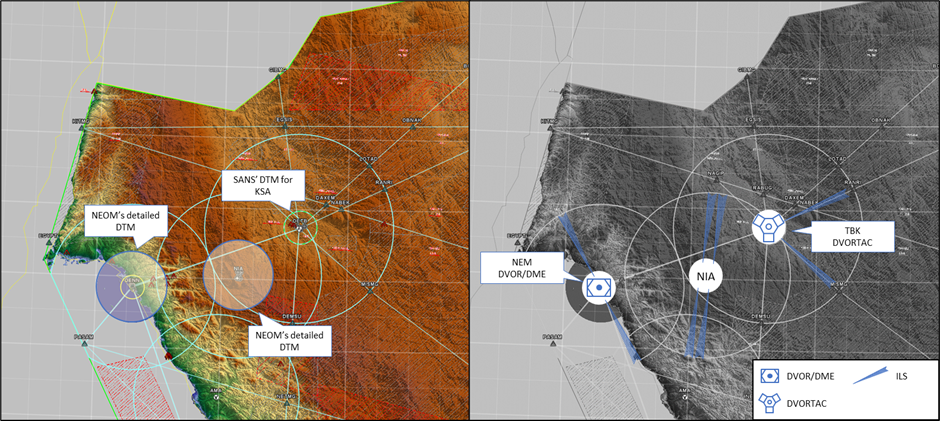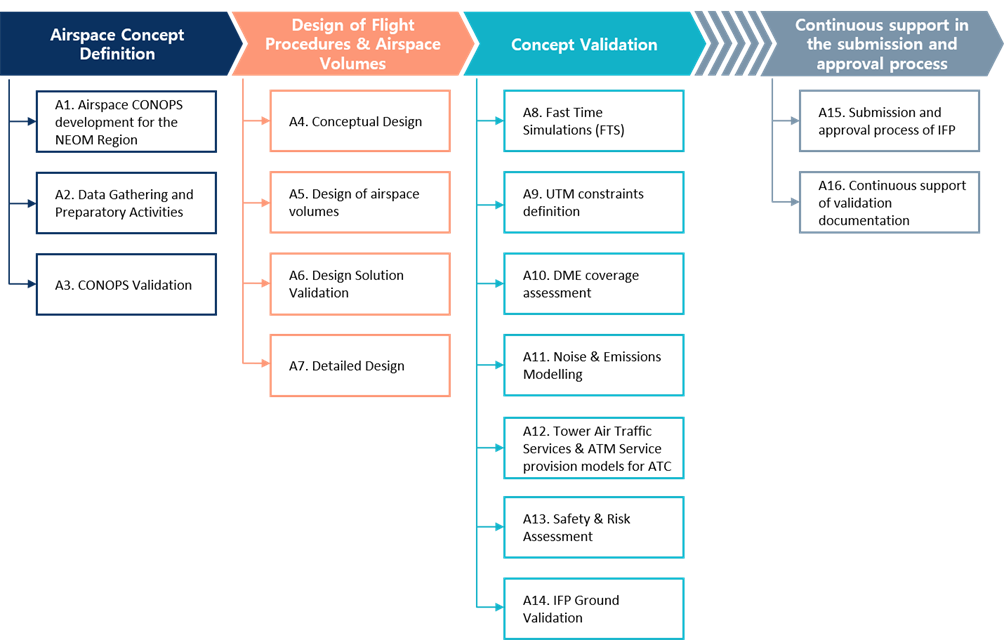In recent years, Neom has been working on developing an innovative concept related to the Instrumental Flight Procedure (IFP) solution for the new Neom International Airport (NIA). The initial concept design identified the preferred ATM concept and cutting-edge technologies to be deployed in Neom, as well as the segregated airspace that needed to be released for efficient commercial flight operations.
A set of design criteria and requirements was derived based on Neom priorities:
- High safety levels
- Minimum environmental impact, both in terms of noise and emissions
- Use of novel concepts and technologies as basic pillars
- Multimodal airspace, with special focus on helicopters and drones
- Efficiency: shortest routes and distance flown
These priorities have been shared with the main aviation stakeholders and were incorporated into the overarching Concept of Operations for the northwest region of Saudi Arabia. ALG’s solution was adopted by Neom, including internal coordination that generated momentum to re-think the northwest airspace of the Kingdom of Saudi Arabia (KSA).
Guided by ALG, the next step was to develop a common design solution, integrated into a homogeneous PBN concept and implementation plan for Neom Bay and Tabuk, to cope with the traffic demand expected in the short and mid-term.

Objectives, goals and purposes
The main objective of the project was to design and validate Concepts of Operations (CONOPS) for the Neom region and design of Flight Procedures and Airspace volumes based on three items: the PBN implementation objectives, NIA airport’s current strategy and operational requirements, and strategic objectives.
Study methodology and activities
The methodology followed a four-stage approach, with each stage entailing a set of activities, as illustrated below:

- Develop a joint Concept of Operations (CONOPS) for the future operations of airports in northwest KSA. This first stage includes initial assessment of the current ANS structure around the airports, gathering of all necessary data, and outlining the design objectives.
- Focus on updating the design solution, which will be performed following the baselines in the CONOPS document. Involvement of all stakeholders in the discussions is considered essential to obtain their qualitative assessment and operational judgement regarding the design proposal(s) presented.
- Describe all activities required to ensure that the design solution is implemented and provides the expected benefits, and that all stakeholders buy in to it.
- Entail continuous support for Neom’s management in updating the final designs, capturing all previous iterations and feedback, and driving the publication of changes.
The project was developed following ICAO Standards and Recommended Practices (SARPS), as well as the local GACAR regulations for IFP design.
Success and outcomes
The airspace design is available to start the implementation phase when the final strategic decisions concerning ground infrastructure and airports for Neom Bay and the future Neom International are made, which will trigger adjustments to the concept. This will be followed by the necessary flight and regulator validations. The charts and design documentation were generated in record time to enable the assessments needed before implementation at the beginning of 2022, with partial implementations probable during 2023.
All Neom units are using the delivered airspace structure as a reference for future developments, such as UAV/UAM concepts, and for land mobility and energy, etc., with the latter having generated two studies for obstacle assessments within the region for ALG.
The airspace concept enables UAV/UAM integration, providing a framework for development of the concept that is compatible with the two-airport system and establishing a base airspace corridor for unmanned traffic.
The project has engaged SANS as a partner in technical decision-making for the conceptual design, introducing the UAM and latest airspace concepts into the KSA operating environments, such as the ATC and safety components, broadening the capabilities of Neom’s airspace.

